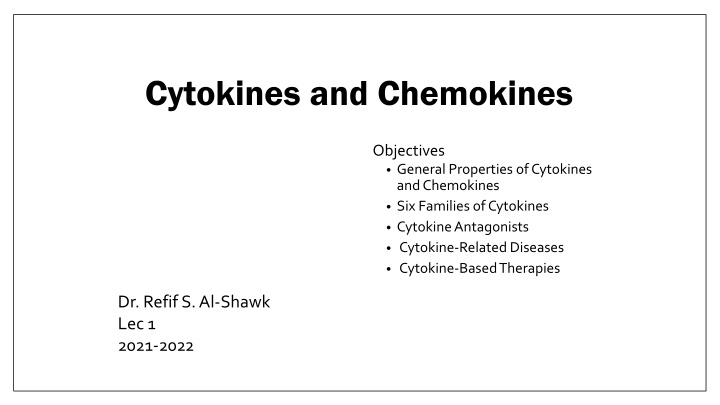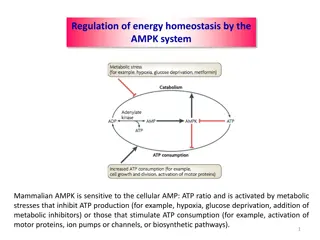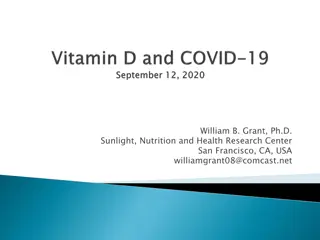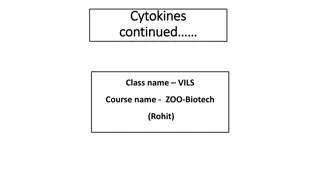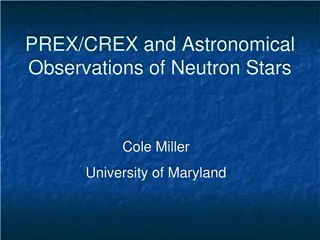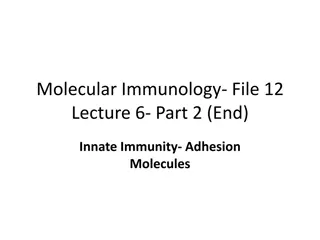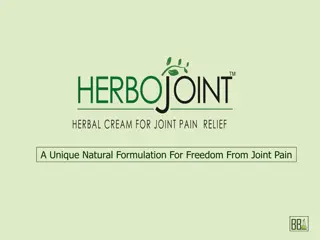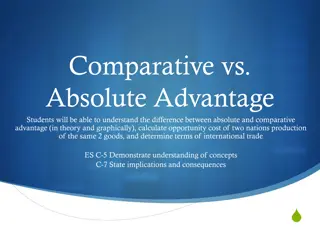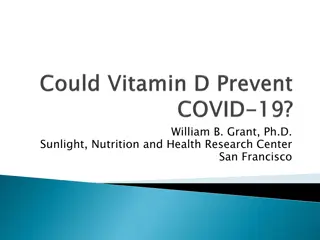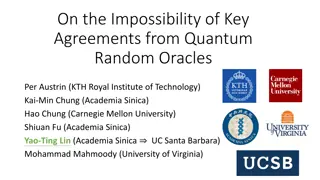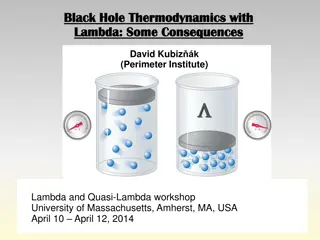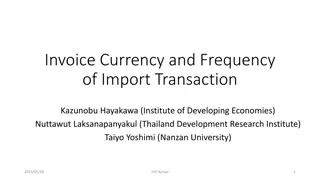Cytokines and Chemokines: Key Concepts and Implications
Cytokines and chemokines are essential signaling molecules that play crucial roles in immune responses. This content covers their general properties, classification, functions, and implications in diseases and therapies. Learn about the diverse families of cytokines, cytokine antagonists, and the various modes of cytokine actions based on distance. Gain insights into the pleiotropic and redundant nature of cytokines, shedding light on their significance in immune regulation.
Download Presentation

Please find below an Image/Link to download the presentation.
The content on the website is provided AS IS for your information and personal use only. It may not be sold, licensed, or shared on other websites without obtaining consent from the author.If you encounter any issues during the download, it is possible that the publisher has removed the file from their server.
You are allowed to download the files provided on this website for personal or commercial use, subject to the condition that they are used lawfully. All files are the property of their respective owners.
The content on the website is provided AS IS for your information and personal use only. It may not be sold, licensed, or shared on other websites without obtaining consent from the author.
E N D
Presentation Transcript
Cytokines and Chemokines Objectives General Properties of Cytokines and Chemokines Six Families of Cytokines Cytokine Antagonists Cytokine-Related Diseases Cytokine-Based Therapies Dr. Refif S. Al-Shawk Lec 1 2021-2022
Learning objectives After reading this lecture, you should be able to: Define cytokines and chemokines describe the general properties of cytokines and chemokines Demonstrate and classify the cytokine families Explain the common features of each family that used by innate and adaptive immune cells and give examples for each family Explain Cytokine antagonists, cytokine related diseases and cytokine-based therapies.
Cytokines Low-molecular weight regulatory proteins or glycoproteins Secreted by WBC and various other cells Assist in regulating development of immune effector cells Referred to as Interleukins IL-1 through IL-37 have been described
Chemokines Subpopulation of cytokines that share the specific purpose of mobilizing immune cells from one organ, or from one part of an organ, to another. Subpopulation of cytokines Mobilize immune cells from one area to another Class of chemoattractants
Cytokines Are Described by Their Functions and the Distances at Which They Act Cytokines can be described according to the distance between the secreting cell and the recipient cell. Cytokines that must pass through the bloodstream before reaching their target are referred to as endocrine. Those that act on cells near the secreting cell, such that the cytokine merely has to diffuse a few angstroms to a nearby cell, are referred to as paracrine. Sometimes, a cell needs to receive a signal through its own membrane receptors from a cytokine that it, itself, has secreted. This type of signaling is referred to as autocrine. Many cytokines act over a short distance in an autocrine or paracrine fashion.
Cytokines can be classified on the basis of the distance between the cell secreting the signaling ligand & the cell receiving that chemical signal : Of note, the T-cell interleukin IL-2 acts effectively in all three modes.
Cytokines Exhibit the Attributes of Pleiotropy, Redundancy, Synergism, Antagonism, and Cascade Induction A cytokine that induces different biological effects depending on the nature of the target cells is said to have pleiotropic activity Whereas two or more cytokines that mediate similar functions are said to be redundant. Cytokine synergy occurs when the combined effect of two cytokines on cellular activity is greater than the additive effects of the individual cytokines. In some cases, the effects of one cytokine inhibit or antagonize the effects of another. Cascade induction occurs when the action of one cytokine on one target cell induces that cell to produce one or more additional cytokines
General Properties of Cytokines and Chemokines: Cytokines bind to specific receptors on the membranes triggering signal transduction pathways that ultimately alter enzyme activity and gene expression. The susceptibility of a target cell to a particular cytokine is determined by the presence of specific membrane receptors and exhibit very high affinity for one another. of target cells,
Cytokines Have Numerous Biological Functions The total number of proteins with cytokine activity grows daily as research continues to uncover new ones . Table 12-1 summarizes the biological functions of some commonly cytokines. encountered
Cytokines belong to 6 families Interleukin 1 (IL-1) Hematopoietin family (Class I) Interferon family (Class II) Chemokine family Tumor necrosis family Interleukin 17 (IL-17) Based on structural studies All have molecular mass less than 30kDa All have similarities and few rarely act alone
Cytokines of the IL-1 Family Promote Proinflammatory Signals Cytokines of the interleukin 1 (IL-1) family are typically secreted very early in the immune response by dendritic cells, monocytes, and macrophages following recognition by innate receptors of viral, parasitic, or bacterial antigens. IL-1 family members are generally proinflammatory. IL-1 also has systemic (whole body) effects and signals the liver to produce other cytokines, such as the type I interferons (IFN- and IFN- ), IL-6, and the chemokine CXCL8. These proteins further induce multiple protective effects, including the destruction of viral RNA and the generation of a systemic fever response (which helps to eliminate many temperature- sensitive bacterial strains). In addition, IL-1 serves as an intermediary between the innate and adaptive immune systems by helping to activate both T and B cells. Members of the IL-1 cytokine family include IL-1 and IL-1 IL-1 family also includes IL-18 and IL-33.
Class 1 Cytokines Share a Common Structural Motif But Have Varied Functions The cellular origins and target cells of class 1 cytokines are extremely diverse. For example, class 1 cytokines signal the onset of T- and B-cell proliferation (e.g., IL-2), regulate helper T-cell functions (e.g., IL-4), call for B-cell differentiation to plasma cells and antibody secretion (e.g., IL-6), or initiate the differentiation of particular leukocyte lineages (e.g., GM-CSF, G-CSF). {The class 1 cytokine family is the largest family of cytokines, and members mediate diverse effects, including proliferation, differentiation, and antibody secretion}
Class 2 Cytokines Are Grouped into Three Families of Interferons The class 2 cytokine (interferon) family includes the following: The type I interferons (IFN- and IFN- ), which mediate early antiviral responses. The type II interferons (such as IFN- ), which activate macrophages, interact with cells of the adaptive immune system, and support the generation of T 1 cells. The type III interferons (IFN- ), which are secreted by plasmacytoid dendritic cells and regulate viral replication and host cell proliferation.
TNF Family Cytokines May Be Soluble or Membrane-Bound Members of the tumor necrosis factor (TNF) family of cytokines have been shown to regulate the development, effector function, and homeostasis of cells of the skeletal and neuronal systems, as well as the immune system. Although some TNF family members are soluble proteins, others are transmembrane proteins, In some cases, the same cytokine exists in both soluble and membrane-bound forms. There are two members having the same name of the TNF family: TNF- and TNF- . Both of these are secreted as soluble proteins. TNF- (frequently referred to simply as TNF) is a proinflammatory cytokine, produced in response to infection, inflammation, and environmental stressors by activated macrophages, and also by lymphocytes, fibroblasts, and keratinocytes (skin cells). TNF- is produced by activated lymphocytes and can deliver a variety of signals. On binding to neutrophils, endothelial cells lead to increased expression of MHC and of adhesion molecules. Fas ligand (FasL), induces apoptosis. Thus members of the membrane-bound TNF cytokine family regulate lymphocyte functions from development to death and everything in between, highlighting their importance in both basic and clinical immunology. It is therefore not surprising that TNF cytokine pathways are the targets of some of the most effective drugs (to counter diseases of the immune system).
The IL-17 Family of Cytokines Is the Most Recently Identified IL-17A, the first member of the IL-17 family to be detected, is released by activated T cells and its receptors are found on neutrophils, keratinocytes, and other nonlymphoid cells. IL-17A binding to a cell instructs it to secrete cytokines that support a proinflammatory state. The T cells secreting these cytokines belong to a unique lineage, the TH 17 cell subset, which appears to occupy a locus at the interface of innate and adaptive immunity interleukins 17A, 17B, 17C, 17D, and 17F. Signaling through most members of this family culminates in the generation of inflammation.
Chemokines Induce the Directed Movement of Leukocytes Structurally related family of small cytokines that bind to cell surface receptors and induce the movement of leukocytes up a chemokine concentration gradient and toward the chemokine source. This soluble factor directed cell movement is known as chemotaxis, and molecules that elicit such movement are referred to as chemoattractants. Leukocytes change their pattern of expression of chemokine receptors during the course of an immune response.
Chemokines play two roles in inflammation: Increased adhesion of leukocytes to endothelium Migration of leukocytes through blood vessels and toward the site of infection or tissue damage. Chemokines are development of lymphoid organs Chemokines are required for the migration of DCs from sites of infection into draining lymph nodes involved in the CXCL group: attract neutrophils CCL group: macrophages, to the site of infection. attract monocytes and
Cytokines produced by cells during innate immune responses to microbes stimulate the proliferation and differentiation of lymphocytes in adaptive immune responses. Examples of cytokines secreted by PAMP stimulated cells acting on B cells, CD4+ T cells, and CD8+ T cells are given here: IL-12 stimulates the differentiation of naive CD4+ T cells to the Th1 subset of effector cells. IL-1, IL-6, and IL-23 stimulate the differentiation of naive CD4+ T cells to the Th17 subset of effector cells. IL-25 and IL-33 stimulate the differentiation of naive CD4+ T cells to the Th2 subset of effector cells. IL-15 promotes the survival of memory CD8+ T cells. IL-6 promotes the production of antibodies by activated B cells .
Cytokine Related Diseases Bacterial Toxic Shock Microorganisms produce toxins that act as Superantigens Bind simultaneously to Class II MHC and T cell receptor, activating T cell despite antigenic specificity ,,induce extremely high levels of TNF- and IL-1 Symptoms similar to sepsis Bacterial Septic Shock Certain bacteria: Staphyloccocus aureus, E. coli, Klebsiella pneumoniae .. Symptoms: drop in blood pressure, fever, diarrhea, blood clotting Endotoxins (cell wall) bind TLRs on dendritic cells and macrophages leading them to produce Over-produce IL-1 and TNF- Cytokine imbalance causes abnormal temp, abnormal respiration, capillary leakage, tissue injury, organ failure Neutralization by monoclonal antibodies may help
A naturally occurring cytokine antagonists that modulate and refine the power of particular cytokine responses, as well as the ways in which various pathogens cytokine responses to their own ends. Cytokine Antagonists have hijacked Number of proteins can inhibit cytokine activity Can bind to receptor but fail to activate the cell, thus blocking the active cytokine from binding, OR Can bind to cytokine, inhibiting its ability to bind to the cognate receptor Regulatory T cells, which express high levels of CD25 on their membrane surfaces, have been shown to release sIL-2R upon activation. Since these T cells serve the function of down- regulating ongoing (soluble IL-2 receptors serve the physiological function of soaking up excess IL-2 ) thus reducing the amount of the cytokine that is available. immune responses, Epstein-Barr virus (EBV), for example, produces an IL-10 like molecule (viral IL-10 or vIL-10) that binds to the IL-10 receptor. Just like host-derived IL-10, this viral homologue suppresses TH1-type cell-mediated responses that would otherwise be effective in fighting a viral infection.
A large number of cytokines and their receptors involved in inflammation are being targeted by specific antagonists for the treatment of chronic T cell mediated inflammatory diseases The first success with this class of biologic agents came with a soluble form of the TNF receptor and anti-TNF antibodies, which bind to and neutralize TNF. These agents are of great benefit in many patients with rheumatoid arthritis, Crohn s disease, and psoriasis. Antibodies to the IL-6 receptor have been successfully used for juvenile and adult arthritis. Antagonists of other proinflammatory cytokines, such as IL-1, the p40 chain that is present in both IL-12 and IL-23, and IL-17, are now approved for various inflammatory diseases, and many others are in clinical trials. In addition to these biologic agents, small molecule inhibitors of JAK kinases (important intracellular signaling mediators of a variety of cytokine receptors) are also approved to inhibit cytokine actions in rheumatoid arthritis.
Cytokine-Based Therapies Soluble TNF- receptor and monoclonal antibodies against TNF- ?? have been used to treat rheumatoid arthritis and ankylosing spondylitis in more than a million patients. Which reduce proinflamatory cytokine cascades; help to alleviate pain, stiffness, and joint swelling; and promote healing and tissue repair. The recombinant form of IL-1R receptor?? has been shown to be relatively effective in the treatment of rheumatoid arthritis. Monoclonal antibodies directed against the IL-2 Receptors ?? are also in clinical use for the prevention of transplantation rejection reactions
Referrences : Kuby immunology 8th edition, 2019 Cellular and molecular immunology 9th edition , 2018 by Abul K. Abbas
Immune Responses: The Outcomes of Immune System Recognition Changes in Protein Expression Facilitate Migration of Leukocytes into Infected Tissues(Alterations in the expression of adhesion molecules and chemokine receptors facilitate the movement of immune cells to the sites of immune activity) Activated Macrophages and Neutrophils May Clear Pathogens without Invoking Adaptive Immunity(Changes in the protease specificity of their proteasomes optimize the capacity of dendritic cells to mediate antigen presentation) Antigen Activation Optimizes Antigen Presentation by Dendritic Cells(The nature of the innate immune receptor engaged in a dendritic cell determines what cytokines the dendritic cell secretes. These in turn determine the type of T-cell response that it initiates) Cytokine Secretion by Dendritic Cells and T Cells Can Direct the Subsequent Immune Response(The nature of the innate immune receptor engaged in a dendritic cell determines what cytokines the dendritic cell secretes. These in turn determine the type of T-cell response that it initiates) Antigen Stimulation by T and B Cells Promotes Their Longer-Term Survival (Antigen activation increases the life span of T and B lymphocytes by inhibiting apoptosis) Antigen Binding by T Cells Induces Their Division and Differentiation (Different subclasses of T cells secrete different cytokines that direct varying aspects of immune effector responses) Antigen Binding by B Cells Induces Their Division and Differentiation(B-cell differentiation results in differentiation to antibody-secreting cells and memory B cells and the production of antibodies of different classes and enhanced binding affinity)
Properties of the major subsets of CD4+ helper T cells. Naive CD4+ T cells may differentiate into distinct subsets of effector cells in response to antigen, costimulators, and cytokines.
Classical and alternative macrophage activation. Different stimuli activate tissue macrophages to develop into functionally distinct populations. Classically activated macrophages are induced by microbial products and cytokines, particularly IFN- , and are microbicidal and involved in potentially harmful inflammation. Alternatively activated macrophages are induced by IL-4 and IL-13 produced by Th2 cells and other leukocytes and function to control inflammation and to promote tissue repair and fibrosis. Some investigators divide the M2 macrophage population into subpopulations, some of which are mainly anti-inflammatory and others are responsible for tissue repair.
A large number of cytokines and their receptors involved in inflammation are being targeted by specific antagonists for the treatment of chronic T cell mediated inflammatory diseases (Table 19.5).
